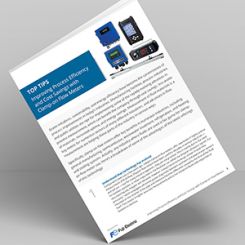Last of Two Parts South East Water had evaluated three septic alternatives for the Mornington Peninsula project: gravity, vacuum and low-pressure sewers (LPS). Gravity sewers—with origins in the Roman aqueducts—are bulky systems usually requiring major, disruptive excavation to install. And, like septic systems, gravity sewer infrastructure can tend to leak and be prone to infiltration and inflow. Navigating the terrain was another consideration. The landscape ranges from undulating plains to low hills, largely sitting upon sandy foundations. Perhaps the biggest drawback of a gravity project was price: approximately $416 million compared with $297.5 million for an intelligent LPS, significantly lower in capital outlays than the competing options. South East Water concluded that the low-pressure system was the best option based on value, whole-of-life worth, quality of equipment and the track record of South East Water’s 15-year history of designing and operating pressure sewers. Besides cost, South East Water considered other benefits of a low-pressure system:
- the need for only a fraction of the pumping stations a gravity system would have required
- lower capital and operating expenditures
- immediate environmental gains and a reduced pollution load
- the absence of inflow and infiltration of ground- and stormwater
- the grinder pumps’ capacity to pump long distances and up challenging elevations at significant head
.jpg) Image 1. Pressure testing the low-pressure sewer pressure main, which ensures all fittings are liquid tight to prevent infiltration or exfiltration (Images courtesy of South East Water)
Image 1. Pressure testing the low-pressure sewer pressure main, which ensures all fittings are liquid tight to prevent infiltration or exfiltration (Images courtesy of South East Water)_0.jpg) Image 2. A contractor attaches the inlet fitting to the tank prior to in-ground installation.
Image 2. A contractor attaches the inlet fitting to the tank prior to in-ground installation.Additional Capabilities
A pilot project is under way to capture rainwater for recycling, which will be beneficial in times of drought. Using a OneBox network to manipulate this storage will provide a flood prevention mechanism. “We have a 500-house development proposal with 500 rain tanks (in the trial),” Casey says. “It will allow us to utilize the available volume in those rain tanks to accommodate peak rainfall events and reduce flooding because we can control all of the levels of the rain tanks and can utilize the available volume at any given moment for peak flood flow mitigation. “The rain tank’s level sensor will communicate via the OneBox system to our control system and actuate valves on the rain tanks to allow us to empty the rain tanks in a controlled manner. We can discharge rainwater into the drainage system ahead of a storm event. We can have a controlled flow from multiple rain tanks into the waterway, which can be easily regulated.” Full acceptance of the concept by workers and other water utilities, however, is not yet universal. “As with any change in technology, there will be some who want to wait to see it in full operation before they have comfort,” Thompson says. “The benefit in this case is that South East Water is both the developer and user of the product. The test bed South East Water has created allows us to demonstrate that the system works. Our focus has been to reduce the operational aspects of managing low-pressure sewer units which you can do remotely. Sixty percent of South East Water’s call-outs were out of hours. These can now be addressed during normal business hours, which saves on overtime on the weekend.”.jpg) Image 3. Completed installation of E/One low-pressure sewer tank with Iota OneBox. Low-profile features and modern industrial design of components make for a more attractive amenity.
Image 3. Completed installation of E/One low-pressure sewer tank with Iota OneBox. Low-profile features and modern industrial design of components make for a more attractive amenity.
